M31 - The
Andromeda Galaxy
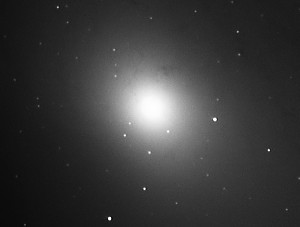
Click the
image to see it at full size (0.96"/pixel). |
M31 - The Andromeda
Galaxy - Core, 9.12.2002 (22:06-22:35 UT)
Resolution: 1.92 arcsec/pixel
Camera: Vesta 675 SC2 at prime focus
Telescope: 8" F6 OrionOptics Europa
Newtonian
Result focal ratio: F6
Exposure: 25x40s (gain 100%, Amp OFF, outdoor
white balance), 10xDF
Captured and processed by K3CCDTools, then in
ACDSee Editor + Neat Image
Seeing: average, temperature about -5°CThis
is my first test of my new Vixen GP-DX mount. All
25 frames of 40s exposure taken in prime focus
were perfect - so I could use them for summation.
This is better efficiency than it was with my GEM1
autoguiding system.
Some structure (dim areas) near the core is
visible. At first I thought, that it was only
some dust in my webcam, but I captured the same
structure in various places of CCD area. Later I
compared them with Digitized Sky Survey picture
and it confirmed, that these structure really
exists.
Processing details:
1, aligned and summed in K3CCDTools
2, histogram stretching + gamma 1.20 in K3CCDTools
3, contrast and gamma adjustment in ACDSee
4, because of bad white balance I decided to
convert picture to grayscale in ACDSee
5, noise reduction in Neat Image
|
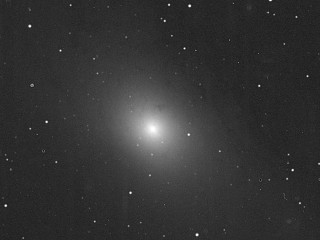
This is photo from Digitized
Sky Survey. You can compare the dim structures
northerly from core.
Click
the image to see it at full size. |
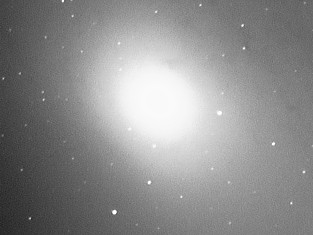
Click the
image to see it at full size (0.96"/pixel).
|
M31
- The Andromeda Galaxy - Core, 9.12.2002 (22:36-22:42
UT)
Resolution: 1.92 arcsec/pixel
Camera: Vesta 675 SC2 at prime focus
Telescope: 8" F6 OrionOptics Europa
Newtonian
Result focal ratio: F6
Exposure: 5x90s (gain 100%, Amp OFF, outdoor
white balance), 4xDF
Captured and processed by K3CCDTools, then in
ACDSee Editor + Neat Image
Seeing: average, temperature about -5°CGP-DX
showed its perfect performance also with 90s
exposures! All 5 captured frames were acceptable.
Processing details:
1, aligned and summed in K3CCDTools
2, histogram stretching + gamma 1.20 in K3CCDTools
3, contrast and gamma adjustment in ACDSee
4, because of bad white balance I decided to
convert picture to grayscale in ACDSee
5, noise reduction in Neat Image
|
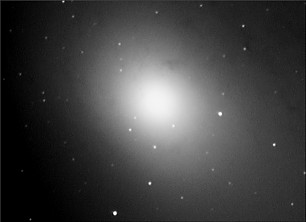
Click the
image to see it at full size (0.96"/pixel).
|
M31
- The Andromeda Galaxy - Core, 9.12.2002 (22:06-22:42
UT)
Resolution: 1.92 arcsec/pixel
Camera: Vesta 675 SC2 at prime focus
Telescope: 8" F6 OrionOptics Europa
Newtonian
Result focal ratio: F6
Exposure: 25x40s + 5x90s (gain 100%, Amp OFF,
outdoor white balance), 10x40s + 4x90s DF
This is combination of above 2 photos. |
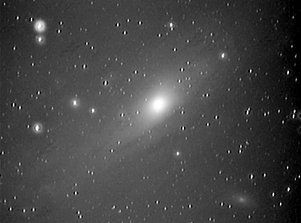
Click the
image to see it at full size (34.7"/pixel). |
M31
- The Andromeda Galaxy, 9.12.2001 (23:00-23:07 UT)
Resolution: 46.2 arcsec/pixel
Camera: Vesta 675SC piggy back on OrionOptics
Europa 200
Objective: 2/50 Flexon
Exposure: 30x120s (gain 20%), 15xDF
The spiral arms are now detectable. Postprocessed
by Loreal. |
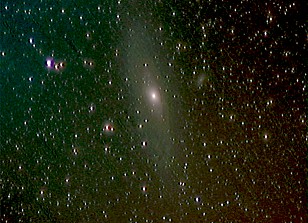
Click the
image to see it at full size (23.1"/pixel).
Click here
to
see to result image (173kB) in K3CCDTools in 2X
mode (11.5"/pixel). |
M31
- The Andromeda Galaxy, 9.12.2001 (23:00-23:07 UT)
Resolution: 46.2 arcsec/pixel
Camera: Vesta 675SC piggy back on OrionOptics
Europa 200
Objective: 2/50 Flexon
Exposure: 28x80s (gain 0%), 10xDF
Seeing: lim.magnitude for naked eye 4.5Gain
of webcam was set to 0% to suppress the noise of
camera. The noise usually affect the quality of
image, because the compression of data is wasted
for compressing the noise and star images are
poor. Such large field photo contains a lot of
stars, that means it contains a lot of
information to be compressed.
The spiral arms are now detectable (particularly
in full size photo)!!!
|
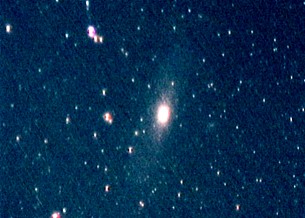
Click the
image to see more processing results and the full
size pictures (23.1"/pixel). |
M31
- The Andromeda Galaxy, 11.11.2001 (0:29 UT)
Resolution: 46.2 arcsec/pixel
Camera: Vesta 675SC at photo tripod
Objective: 2/50 Flexon
Exposure: 20x5s (gain 100%), 25xDF
Seeing: lim.magnitude for naked eye 4.5The
farthest object visible by naked eye. The core of
galaxy is bright, but the spiral arms are very
dim. Very difficult object for astrophotography.
|
Back to Messier
Catalog
Computer generated images,
real images, drawings and texts are property of the
author and may not be reproduced or used without
permission of author.

Last Update:
10.08.2003
|